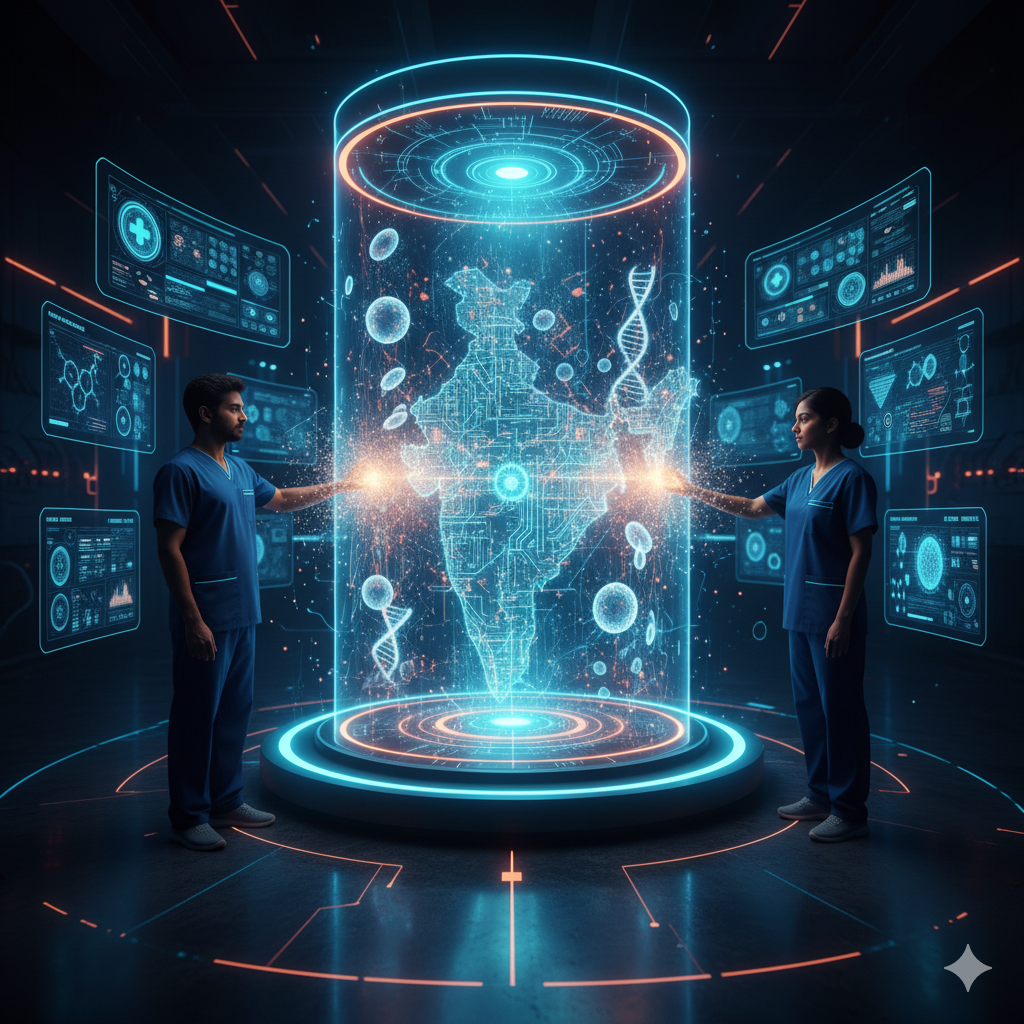Introduction
Augmented Reality (AR) is revolutionizing various industries, and one of the most promising areas of its application is healthcare and surgery. AR-powered healthcare and surgery simulations are changing the way medical professionals learn, practice, and perform complex procedures. By integrating digital elements with the real-world environment, AR enhances visualization, provides real-time data, and improves surgical precision.
From medical training and patient diagnostics to real-time surgery assistance, AR is proving to be a game-changer in modern medicine. This article delves deep into AR-powered healthcare and surgery simulations, covering their applications, benefits, challenges, and future prospects.
Understanding AR in Healthcare & Surgery
Augmented Reality (AR) is a technology that overlays digital content, such as 3D images, real-time data, and interactive simulations, onto the physical world. Unlike Virtual Reality (VR), which creates a fully immersive digital environment, AR blends digital information with reality, allowing users to interact with both seamlessly.
In healthcare and surgery, AR plays a crucial role in enhancing medical education, preoperative planning, real-time surgery guidance, and patient care. Surgeons, medical students, and healthcare professionals can visualize complex anatomical structures, practice surgeries in a risk-free environment, and improve accuracy in real-world procedures.
Key Applications of AR in Healthcare & Surgery
1. Medical Training & Education
Medical education has traditionally relied on textbooks, cadavers, and physical models for training. However, AR introduces an interactive and immersive approach to learning.
- 3D Anatomy Visualization: AR applications allow medical students to explore detailed 3D models of human organs, tissues, and systems. This enhances their understanding of complex anatomical structures.
- Interactive Simulations: AR-powered simulations enable students to practice medical procedures without the need for real patients, reducing risks and improving skill development.
- Remote Learning: AR-based platforms support remote medical education, enabling students to learn from expert surgeons and instructors worldwide.
2. Surgery Planning & Preparation
Preoperative planning is critical for the success of complex surgical procedures. AR enhances this process by providing high-resolution 3D visualizations of a patient’s anatomy.
- Personalized Surgery Plans: AR helps surgeons create personalized surgical plans based on a patient’s CT scans and MRI data. This improves accuracy and reduces complications.
- Virtual Mock Surgeries: Before performing a real surgery, surgeons can practice on AR-based virtual models, improving their confidence and preparedness.
- Minimized Surgical Risks: With precise anatomical mapping, AR helps identify potential complications before surgery, leading to better patient outcomes.
3. Real-Time Surgery Assistance
AR is becoming an essential tool in operating rooms, offering real-time guidance and enhancing a surgeon’s capabilities.
- Augmented Visualization: AR overlays real-time data, such as blood vessel structures and tumor locations, onto a patient’s body, helping surgeons navigate complex procedures.
- Hands-Free Information Access: Surgeons can access critical patient data, X-rays, and medical records through AR headsets without interrupting the procedure.
- Precision and Accuracy: AR-powered navigation systems enhance surgical precision, especially in minimally invasive procedures like laparoscopic and robotic surgeries.
4. Patient Diagnosis & Treatment
AR is also transforming patient care by improving diagnosis and treatment options.
- Enhanced Diagnostic Imaging: AR integrates medical imaging with real-time visualization, allowing doctors to detect diseases and abnormalities with greater accuracy.
- Physical Therapy & Rehabilitation: AR applications guide patients through rehabilitation exercises, ensuring correct movements and faster recovery.
- Pain Management: AR-based distractions, such as interactive environments, help reduce pain and anxiety during medical procedures.
5. AR in Emergency & Trauma Care
In emergency situations, quick decision-making is crucial. AR assists paramedics and emergency room doctors in providing faster and more effective care.
- On-Site Patient Assessment: AR-powered applications help paramedics assess injuries, detect fractures, and guide immediate treatments.
- Remote Expert Assistance: AR allows emergency teams to connect with specialists in real time, receiving step-by-step guidance during critical procedures.
- Navigation for First Responders: AR navigation systems help emergency responders reach accident sites faster by overlaying real-time route information onto their field of view.
Benefits of AR-Powered Healthcare & Surgery Simulations
1. Enhanced Learning & Skill Development
AR offers an interactive approach to medical training, enabling students and professionals to develop skills through immersive experiences.
2. Increased Surgical Precision
AR provides real-time, high-resolution visual data, helping surgeons make more precise incisions and reducing surgical errors.
3. Reduced Medical Risks
By allowing preoperative simulations and real-time guidance, AR minimizes the risks associated with complex procedures.
4. Cost-Effective Medical Training
Traditional medical training requires expensive equipment and cadavers. AR-based simulations reduce these costs while providing realistic practice environments.
5. Improved Patient Experience
Patients benefit from better diagnostics, minimally invasive procedures, and personalized treatment plans, leading to faster recovery and improved outcomes.
Challenges & Limitations of AR in Healthcare
Despite its advantages, AR-powered healthcare and surgery simulations face several challenges:
1. High Implementation Costs
Developing and integrating AR technology into healthcare systems require significant investment in hardware, software, and training.
2. Technical Limitations
- AR devices require high processing power and advanced sensors to deliver accurate real-time data.
- Hardware, such as AR headsets and smart glasses, needs to be lightweight and user-friendly for widespread adoption.
3. Data Privacy & Security Concerns
- AR applications handle sensitive patient data, raising concerns about cybersecurity and HIPAA compliance.
- Strict data encryption and access control measures are required to protect patient information.
4. Learning Curve for Healthcare Professionals
- Many doctors and surgeons are unfamiliar with AR technology and may require additional training.
- The transition from traditional methods to AR-powered solutions takes time and effort.
5. Dependence on Reliable Internet & Hardware
- AR applications require stable internet connections and high-performance computing systems.
- Poor connectivity or outdated devices can hinder the effectiveness of AR in medical settings.
The Future of AR in Healthcare & Surgery
The future of AR-powered healthcare and surgery simulations looks promising, with continuous advancements expected in the coming years.
1. AI & AR Integration
Artificial Intelligence (AI) will enhance AR capabilities by providing real-time analytics, predictive modeling, and automated diagnostics. AI-powered AR can assist surgeons by identifying anomalies and suggesting optimal surgical approaches.
2. 5G-Powered AR Applications
Faster internet speeds will improve AR responsiveness, making real-time remote surgeries and virtual consultations more effective.
3. AR & Robotics in Surgery
AR-powered robotic surgery will enable surgeons to perform complex procedures with higher precision and minimal invasiveness. Robots guided by AR visualizations will assist in delicate surgeries, reducing human errors.
4. Augmented Telemedicine & Virtual Consultations
Patients will be able to consult doctors through AR-powered telemedicine platforms, receiving real-time visual diagnoses and treatment recommendations.
5. Widespread Adoption in Medical Schools & Hospitals
As AR technology becomes more affordable and accessible, medical institutions will integrate it into their standard training programs and healthcare services.
Conclusion
AR-powered healthcare and surgery simulations are transforming the medical industry by enhancing education, improving surgical precision, and advancing patient care. By offering immersive training experiences, real-time surgical assistance, and innovative treatment solutions, AR is paving the way for a more efficient and effective healthcare system.
While challenges such as cost, data security, and technical limitations remain, continuous advancements in AI, 5G, and AR hardware will drive widespread adoption in the coming years. As the medical field embraces AR, we can expect safer, more accurate, and more accessible healthcare solutions for professionals and patients alike.




